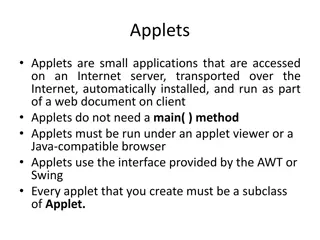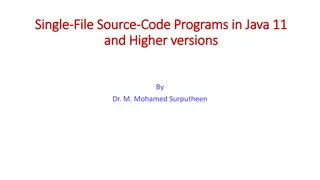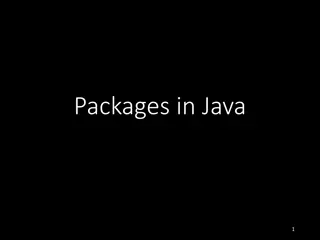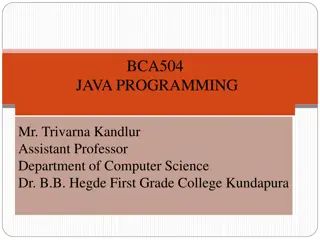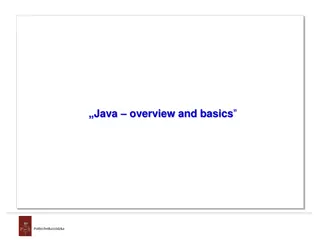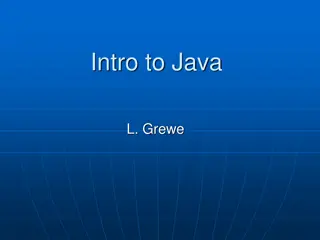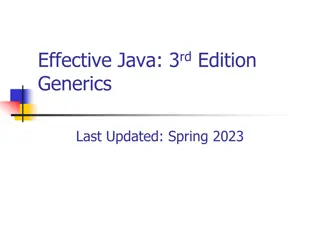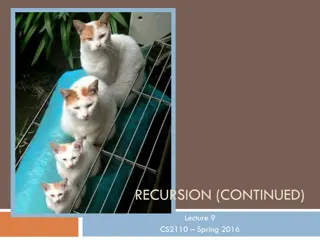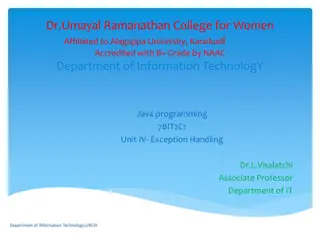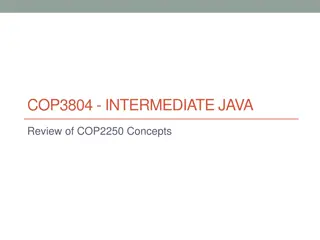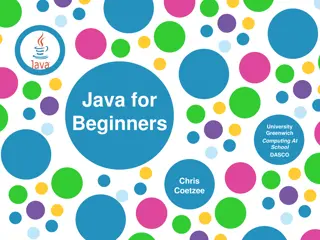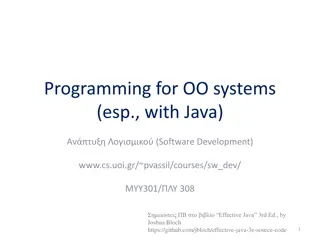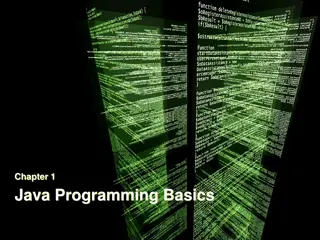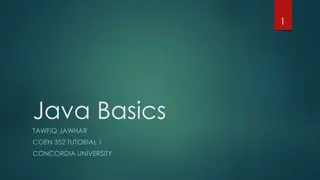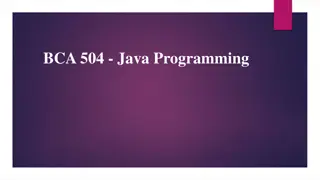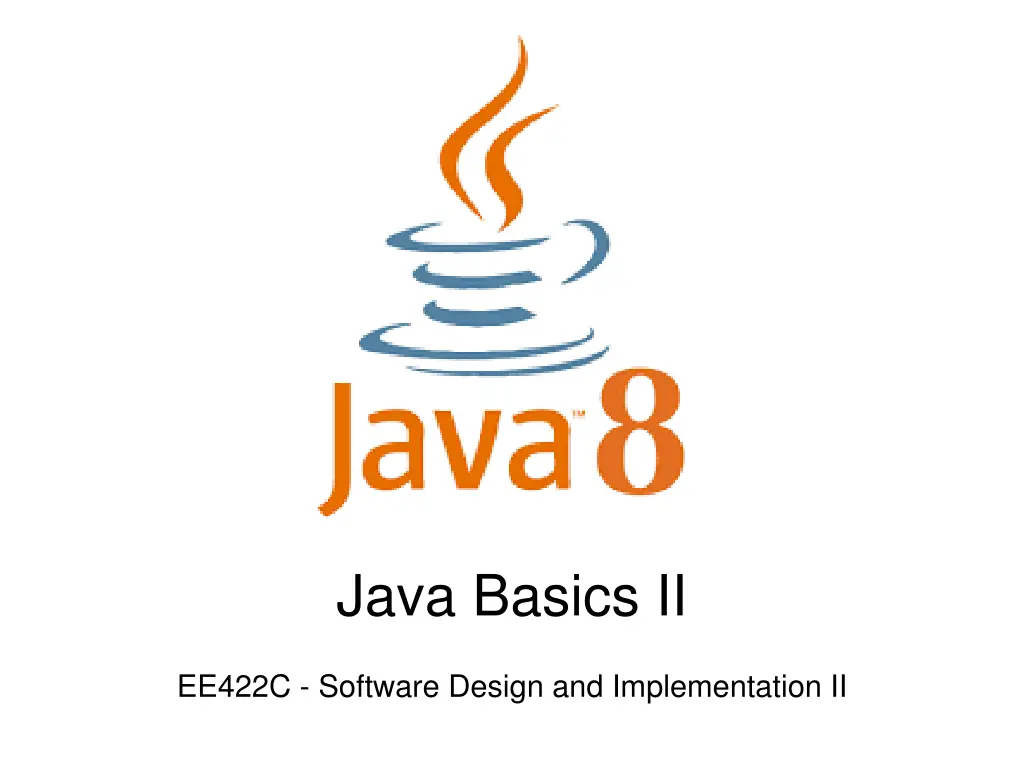
Understanding Java Basics II: Memory Allocation, Reference Types, and Access Specifiers
Explore the fundamentals of memory allocation, reference types, and access specifiers in Java. Learn about static, stack, and heap memory, as well as the usage of public, private, protected, and default access specifiers.
Download Presentation

Please find below an Image/Link to download the presentation.
The content on the website is provided AS IS for your information and personal use only. It may not be sold, licensed, or shared on other websites without obtaining consent from the author. If you encounter any issues during the download, it is possible that the publisher has removed the file from their server.
You are allowed to download the files provided on this website for personal or commercial use, subject to the condition that they are used lawfully. All files are the property of their respective owners.
The content on the website is provided AS IS for your information and personal use only. It may not be sold, licensed, or shared on other websites without obtaining consent from the author.
E N D
Presentation Transcript
Java Basics II EE422C - Software Design and Implementation II
Java Basics II Memory Allocation Reference Types Wrapper Classes Strings
But first Access Specifiers (public, private, protected) Portability Pointers and memory addresses
Access Specifiers: Public Different packages Member and method are public OK
Access Specifiers: Protected 1 Different packages Method is protected ERROR
Access Specifiers: Protected 2 Same package Subclass OK
Access Specifiers: Protected 3 Same package OK
Access Specifiers: Default Different package ERROR
Access Specifiers: Private Member only accessible within its class ERROR
Access Specifiers Which one to use? Always apply most restrictive specifier unless you have a good reason not to Private member variables and public methods
Pointers and Addresses Statement that alluded to the fact that it was not possible to access memory addresses in Java Clarify: it is not possible to cause major havoc with memory addresses in Java Reference types store memory addresses of objects, but Java limits how these can be used
Memory Allocation Three chunks of memory Static: program, static variables Stack: method activation record (local vars, params, info about method) Heap: anything that is dynamically allocated (i.e., new)
Reference Variable Data Types Objects behave differently than the primitive types Only four basic actions that can be applied: 1. Apply a type conversion 2. Access an internal data field if its visible 3. Call a visible method via the dot operator (.) 4. Use the instanceof operator
Reference Variable Data Types Which actions cannot be applied? Object_A * Object_B No logical meaning: not allowed Object_A + Object_B No guarantee it is an object In C/C++, arithmetic on pointers is allowed This often leads to sadness
Simple Object Declaration & Creation public class Circle { private double radius; public Circle(double r) { radius = r;} //constructor public double getRadius() {return radius; } public void setRadius(double r) {radius = r; } public double getArea() { return Math.PI * radius * radius; } public double getPerimeter() {return 2.0 * Math.PI * radius;} }
Simple Object Declaration & Creation // in the main method of the driver class . . . Circle myCirc; myCirc = new Circle (2.0); double theArea = myCirc.getArea(); double thePerim = myCirc.getPerimeter(); . . . myCirc = null; //what happens? What happens to myCirc?
More about Reference Types Assignment (=) Values are copied from rhs to lhs For objects it s the address of that is copied Equality testing (==) For object vars it is testing the equality of the addresses, not the objects referred to Use an equals method for that purpose if (string1.equals(string2)) . . . Parameter passing (when calling a method) For reference vars, the address is passed
Wrapper Classes Classes that encapsulate a primitive type within an object Along with autoboxing/unboxing, and the various conversion methods this allows the mixture of primitives and objects in expressions Builtin wrapper classes are: Double Float Integer Long Short Byte Character Boolean They contain methods that allow us to fully integrate the primitive types into Java s object hierarchy
Wrapper Class for Integers As well as constructors for integer values 24
Autoboxing and Auto-unboxing When a primitive type is automatically encapsulated (boxed) into an equivalent object type wrapper when needed Or done explicitly like Integer.parseInt (stringVariable) When the value of a boxed object is automatically extracted into a primitive value when needed Example Integer i1 = new Integer (1234); int i2 = 33; i1 = i1 + i2: System.out.println(i1);
String Objects Strings are represented by objects (String) String variables are declared and may be initialized String name = Ned Logan ; Same basic operations as all reference vars, except + A String is a composite data object built from instances of the primitive data type char (in Unicode) String objects are immutable Static quoted strings are automatically converted into String objects.
What do we do with Strings? Input and output them Make a bigger String out of little ones Break big Strings into smaller ones Do comparisons (like in chars) Extremely useful in any application that manipulates text (e.g. translators, word processors, language puzzles, etc.)
The String Class You cannot modify a String object If you attempt to do so, Java will create a new object that contains the modified character sequence String myName = Elliot Koffman ; myName = Koffman, Elliot ; 28
How characters are stored in Strings Each character in a String is in a sequential position. Each position has a number starting with position 0 String name = Ned Logan ; // is stored as: Position # 0 1 2 3 4 5 6 7 8 String contents N e d L o g a n The number above each character specifies its position number (sometimes called its index number) in the sequence Each character is Unicode
Escape sequences escape sequence: A special sequence of characters used to represent certain special characters in a string. \t tab character \n new line character \" quotation mark character \\ backslash character Example: System.out.println("\\hello\nhow\tare \"you\"?\\\\"); Output: \hello how are "you"?\\
String Methods There are lots of useful operations and library methods found in the String class Checking length, extracting single chars, extracting substrings, concatenation String greeting = "hello"; int len = greeting.length( ); // len is 5 char ch = greeting.charAt( 1 ); // ch is 'e' String sub = greeting.substring( 2, 4 ); // sub is "ll String age = 9 ; String s = He is + age + years old ; System.out.println (s); // He is 9 years old
Comparing Objects You can t use the relational or equality operators to compare the values stored in strings (or other objects) (You will compare the pointers, not the objects!) if (myName == anyName) .. if (myName.equals(anyName)) ..
Conversions To convert a number to String format you can simply concatenate it with the empty String String numString = + 7; Or use toString method in the appropriate wrapper class String numString = Integer.toString (7); To convert a String to a number you need the help of some special methods found in the wrapper classes String aString = 24 ; int age = Integer.parseInt (aString); aString = 75.99 ; double price = Double.parseDouble (aString); If a String does not have a legal numeric value then your program throws an exception toString() also works on converting objects to string
Some Useful String Methods - for searching, picking apart, comparing, etc. - All are called for a reference string variable: str.method(args) substring (start) - Returns the substring of the reference String starting at index start through the end of the String. substring (start, end) - Returns the substring of the reference String starting at index start through index end-1. indexOf (a) - Returns the index (int) of the first occurrence of String a or char a in the reference String. Returns -1 if not found. indexOf (a, start) - Returns the index (int) of the first occurrence of String a or char a in the reference String that occurs at or after index start. equals (String) - Test two Strings for equality (boolean) compareTo (String) - tests two Strings for lexicographical ordering; returns an int for <, >, =
More String methods Comparison methods: string1 and string2 are String variables with values boolean results = false; // results is a boolean variable If (string1.equals(string2)) results = true; // true if same contents If (string1.equalsIgnoreCase(string2)) results = true; //true if same contents without considering capitalizations String searching methods String str = Now is the time for all good men + to come to the aid of their country. ; int i = str.indexOf( the ); // i = 7 int j = str.lastindexOf( the ); // j = 55 Upper and Lower case conversion toUpperCase, returns an all uppercase version of the String toLowerCase returns an all lowercase version of the String
Advanced String Operations StringBuilder class Like String but not immutable, can expand/contract StringBuffer class Mutable and safe for use by multiple threads. StringTokenizer class Used to break up a String into tokens - beware of delimiter issues - cannot always use this easily String formatting Like using sprintf () in C - the format specification follows the same rules Browse the Java API for more string operations



